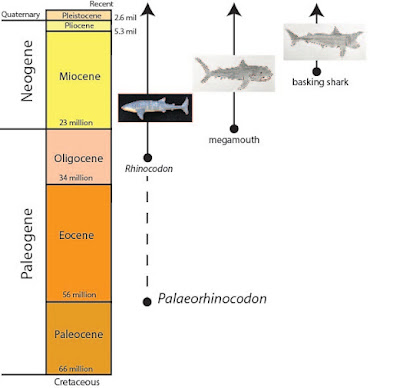The modern-day whale shark Rhinocodon typus (family Rhinocodontidae) is dark gray in color with white spots and stripes. Its body has a very wide and squarish head (up to 5 feet wide) with many (about 300), rather small, single-cusped teeth. The whale shark is commonly referred to as a whale because of its large size, but Rhinocodon typus is a shark, not a whale. A whale is a mammal, and the whale shark is a giant filter- feeding elasmobranch (shark = a fish). The whale shark is the largest known shark today, thus it is the largest known living fish. It can up to about 40 feet in length. The first three images show the left side, top, and front (mouth) views of a model of R. typus.
The whale shark is a slow-moving fish that is found globally today, except in the Mediterranean Sea. It likes tropical waters, and is known to seasonally congregate in the following areas: California to Chile, especially in the Gulf of California (=”Sea of Cortez”) in Baja California (Mexico); Yucutan (Mexico); Belize; Western Australia (especially lagoons and coral atolls) to Japan; Maldives Island (Indian Ocean); and New York to central Brazil.
Whale sharks feed on microscopic zooplankton (copepods) and, to a lesser degree, on small fish, fish eggs, and small squids. They are filter feeders: they have modified pads (gill rakers) along their gills and can screen the water for food as it moves through the gills. For their larger prey, they use suction feeding (sucking in large quantities of water containing the food). Whale sharks are harmless to humans. Their teeth are small.
As shown in the diagram above, the earliest known “whale” sharks lived approximately 56 million years old (late Paleocene or early Eocene in age) and belong to the genus Palaeorhinodon. Their teeth, which are small and single cusped, have been found in Africa, central Asia, Europe, and eastern North America (e.g., South Carolina and Virginia). Their geographic distribution coincides with the ancient Tethys Sea, which stretched from Java and India and westward through southern Europe. These warm waters affected, as well, the east coast of the United States. To my knowledge, they did not live along the west coast of the United States during this time even though the climate was warm there.
Also, as shown in the diagram above, the first known whale shark belonging to genus Rhinocodon appeared during the middle Oligocene, about 28 million years ago. Their teeth, which are also small and single cusped, have been found along the east coast of North America, where warm warms lingered. They did not occur along the west coast of the United States because of continued climate cooling in this area. The fossil record of Rhinocodon ranges from the middle Oligocene to modern times.
In the modern oceans, in addition to whale sharks, there are two other similar looking, giant filter-feeding elasomobranchs: megamouth sharks, and basking sharks. Their geologic time ranges are younger than that for whale sharks (see diagram below).
Furthermore, “Megachasma pelagios was discovered in 1976 off the coast of the Hawaiian Islands. The specimen shown below is the second megamouth ever found. It was caught by commercial fishermen in 1984 near Catalina Island, southern California. it is a 14.7-foot make, weighing approximately 1,540 pounds. In 1990, a live megamouth shark was caught off the coast of Dana Point, southern California. It was fitted with sonic transmitters and released. The transmitters revealed that the shark spends most of its time well below the surface, spending the night 50 feet below the surface, diving to 490 feet at dawn, and returing to shallower waters at dusk. Many marine animals display this vertical migration pattern as they follow plankton in the water.” (From signs displayed at the megamouth exhibit at the Los Angeles County Museum of Natural History, 2021). A head shot of this actual specimen is shown below:
The basking shark genus/species Cetorhinus maximus) is shown below. It is the world’s second largest fish (36 feet long). Like the whale shark and megamouth, the basking shark is a surface-feeder that eats plankton. It prefers temperate waters and shuns polar and equatorial waters. The geologic range of C. maximus is middle Miocene (15 million years ago) to today.
















